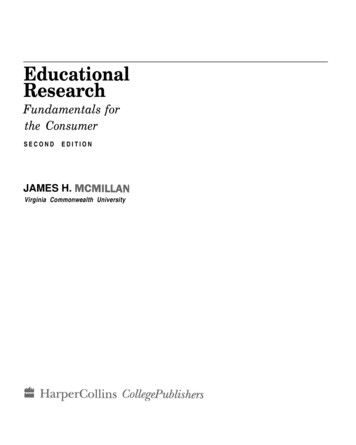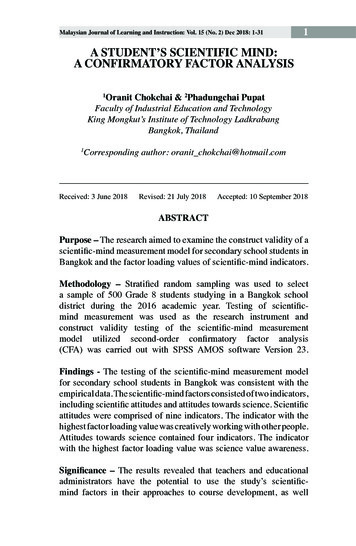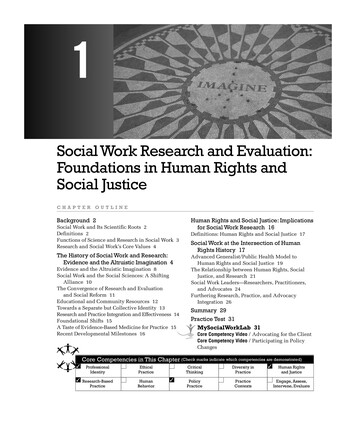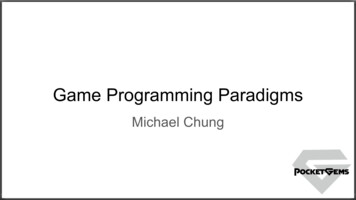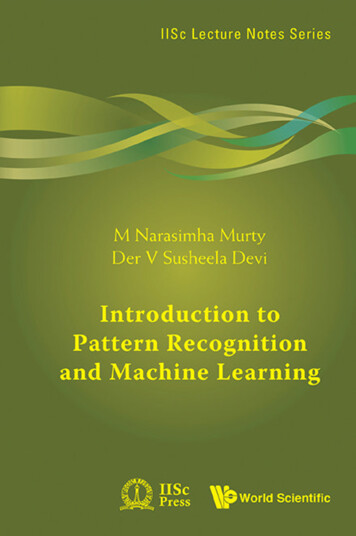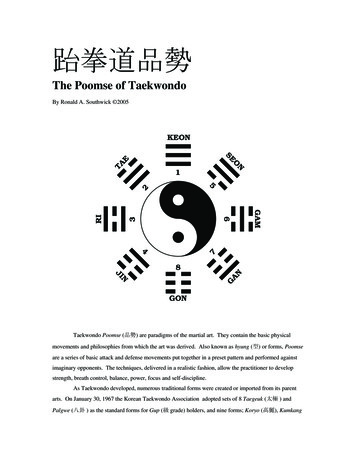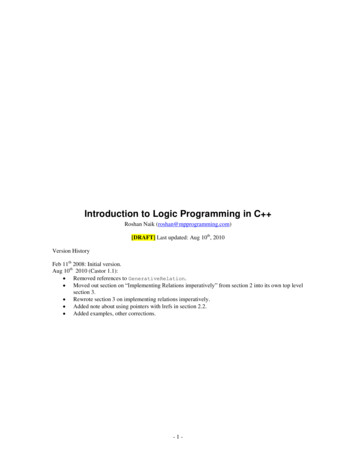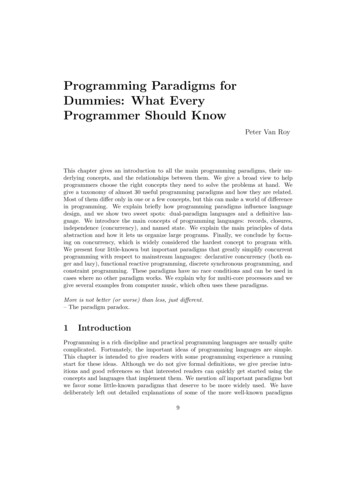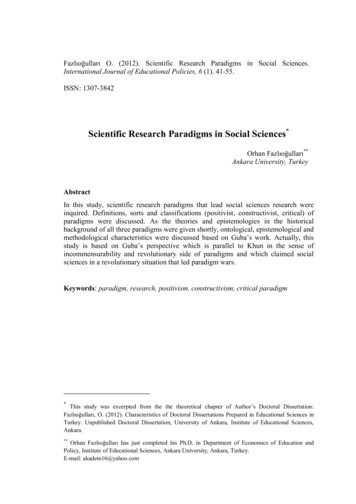
Transcription
Fazlıoğulları O. (2012). Scientific Research Paradigms in Social Sciences.International Journal of Educational Policies, 6 (1). 41-55.ISSN: 1307-3842Scientific Research Paradigms in Social Sciences*Orhan Fazlıoğulları**Ankara University, TurkeyAbstractIn this study, scientific research paradigms that lead social sciences research wereinquired. Definitions, sorts and classifications (positivist, constructivist, critical) ofparadigms were discussed. As the theories and epistemologies in the historicalbackground of all three paradigms were given shortly, ontological, epistemological andmethodological characteristics were discussed based on Guba’s work. Actually, thisstudy is based on Guba’s perspective which is parallel to Khun in the sense ofincommensurability and revolutionary side of paradigms and which claimed socialsciences in a revolutionary situation that led paradigm wars.Keywords: paradigm, research, positivism, constructivism, critical paradigm*This study was excerpted from the the theoretical chapter of Author’s Doctoral Dissertation:Fazlıoğulları, O. (2012). Characteristics of Doctoral Dissertations Prepared in Educational Sciences inTurkey. Unpublished Doctoral Dissertation, University of Ankara, Institute of Educational Sciences,Ankara.**Orhan Fazlıoğulları has just completed his Ph.D. in Department of Economics of Education andPolicy, Institute of Educational Sciences, Ankara University, Ankara, Turkey.E-mail: akadem16@yahoo.com
Scientific Research ParadigmsParadigmThe use of paradigm as shared set of beliefs and practices that lead and guide a field indoing scientific studies (Morgan, 2007) was began by Khun (1970/2006) for physics.While Khun (1970/2006), with the concept of paradigm claimed that the scientificdevelopment was revolutionary rather than linear form; according to Grant, (2006)Khun showed that scientific agenda was determined not only by the theoreticalproblems, experimental results or faculty squabbles but also by the funding pressuresand peer groups. This paradigm concept of Khun was used in social sciences to definethe increasing interest to qualitative research: In 1970’s, while the increasing interestto qualitative research was seen as addition of some new techniques to existing onessome of the researchers like Egon Guba and Yvonna Lincoln described it as arevolutionary state as paradigm revolutions in physics (Donmoyer, 2008). In sociology,researchers generally classified theories or research strategies as paradigms: Ritzer,made a classification of social compounds, social facts and social behavior as threeparadigms; for macrosociology, Bottomore (1975) identified four paradigms(structural-functionalist, evolutionist, phenomenologist, and structuralist). (Cohen,2000).According to Lincoln and Guba, in social sciences, qualitative methods beingused by researchers can not be interpreted just as a methodological diversity; at leastsome of these researchers have completely different beliefs about knowledge(ontological and epistemological): knowledge is constructed not discovered(Donmoyer, 2008). The best known approach to create alternative to positivism is themodel of Egon Guba and Yvonna Lincoln which differentiate the paradigms based ontheir components (ontology, epistemology, methodology) come from philosophy ofknowledge (Morgan, 2007).Lincoln and Guba added the critical paradigm (Guba, 1990) as the thirdparadigm to the list of the perspectives that they considered to be efficient in the fieldsof social sciences in the course of time (Guba, 1994).Guba (1990) expresses that these paradigms, which may also be mentioned as“scientific research paradigms”, can be qualified according to the answers to theontological, epistemological and methodological questions their followers provide.“Ontology”: It is the theory of what exists (Kalof and et al. 2008); they are the basicopinions about the nature of what is known or reality (Guba, 1990); it is thepresentation of worldview or reality peculiar to a certain theory or paradigm (Jennings,2005). “Epistemology”: It examines the problematic of what is the relationshipbetween the one who knows and what is known, and what can be deemed asknowledge (Guba, 1990); the science of knowledge; the relationship betweenresearcher and what is known; this relationship assumes an objective or subjectiveposture (Billings and Jennings, 2000); it is about what can be known (Kalof and et al.2008) “Methodology”: It is about how researcher carries out study on revealinginformation (Guba, 1990); it draws a comprehensive frame in order to determine themethod to know reality and to achieve the knowledge on reality, research question,process steps to be applied and the methods to be used.42
Scientific Research ParadigmsParadigms are restrictive in respect of their philosophy and generalperspectives; they tell what is important, legal or reasonable to their followers orappliers: This is a normative quality indicating for the appliers on what they should dowithout considering epistemological thinking or what they have needed for a long time(Patton, 2002). Since the paradigms are not of a common theoretical language, theycannot be compared (Khun, 1970/2006); as a result of this, the question of ‘whichparadigm is the best?’ does not have an answer.Paradigm ClassificationsThe three paradigms (positivist-constructivist-critical) which differs in ontological,epistemological, and methodological aspects, in the classification of this study is alsocommonly included in the paradigm classification of the most researchers (Table 1).Table 1. Three Basic Paradigms within the context of their Basic t ParadigmNaive realismDualist/objectivist;findings trueConstructivist ParadigmCritical ParadigmHistorical realism: virtualreality shaped by social,Relativism: local andpolitical,cultural,specific constructed andeconomic, ethnic, andco-constructed realitiesgendervalues;crystallized over timeTransactional/subjectivist; Transactional/subjectivist;created findingsvalue-mediated findingsExperimental/manipulative; verification ofhypotheses;chieflyquantitative al(Adapted from Guba and Lincoln, 2005)In Guba’s (1990) classification, postpositivist paradigm has been discussed as aseparate paradigm and a quartet classification (positivist, postpositivist, constructivist,and critical) has been made by differentiating in the aspects of ontology, epistemology,methodology. The classifications of the two paradigms (positivist-postpositivist)43
Scientific Research Paradigmswhose basic assumptions are not different in respect of the aims are emphasized thechange in positivism instead of the existence of two completely different paradigms.discussed separatelyBurrel and Morgan (1979) have made a quartet classification (radical humanist– radical structuralist, interpretative – functionalist) according to the change-regulationand subjectivity-objectivity dualities in order to analyze the social theory. They havematched the aspects of the nature of science (subjective-objective) and the nature ofsociety (change - regulation) on a matrix (Table 2). In this way, every cell correspondsto a certain paradigm.Table 2. Paradigms in accordance with the Nature of Science and SocietyRadical changeRegulation(Sociology of radical change)(Sociology of Regulation )SubjectiveRadical HumanistInterpretativeObjectiveRadical StructuralistFunctionalist(It is quoted from Sociological Paradigms and Organization Analysis by Burreland Morgan, 1979)Lather (2006) has made a quartet classification (Positivist, Interpretative, Critical, andPostmodern) by emphasizing the aims such as prediction, understanding,emancipation, deconstruction and added postmodern paradigm/ paradigms to the basicthree classifications in this context (Table 3). She points out that a transition has beenmade to postmodernist, poststructuralist, posthumanist theory/discourse after a breakhas occurred from the modernist, constructivist, humanist theory/discourse. Accordingto this classification positivist, constructivist and critical paradigms are modernistparadigms.44
Scientific Research ParadigmsTable 3. Lather’s Quartet ePostmodernistDeconstructR istE ntedA tivismPostteoriPost-postetc.etc.etc.(Adapted from Paradigm Classification by Patti Lather, 2006)Neuman (2009), on one hand, indicates that positivist, interpretive and critical socialsciences are three important approaches, on the other hand that feminist andpostmodern researches are less-known, achieved visibility after 1980’s, and they arealternatives which criticize positivism based on interpretative and critical socialsciences.Guba and Lincoln (2005) have added a fifth category called as participatory toGuba’s quartet structure. Here participatory paradigm stresses on that it is anoutstanding deficiency for the positivist scientists to have been broken off from theworld and it purports that researcher should also participate in research and so resultsshould be established together.Analyzing the development of educational science in Germany, Wulf (2010)indicates that these three different paradigms (humanist pedagogy, empiricaleducational science, and critical theory) play an important role on the development ofeducational science.Mackenzie and Knipe (2006) have made a different quartet classificationincluding positivist/postpositivist, interpretative/constructivist, transformative andpragmatic. Pragmatic paradigm ensures utilization of the paradigm providing the bestanswer to the research question by means of its situational feature.Johnson and Christensen (2004), who remark that there are three great researchparadigms in education, have adopted a qualitative, quantitative, mixed classificationwhich is rather described as research design or approach and brings data forms(qualitative/quantitative data) into mind.Garrison and Shale (1994) designate positivist social science, interpretativesocial science and critical social science as the leading role while they state that thefeminist, postmodern and action research are the sub-characters. Neuman (2009) alsoexpresses that feminism and postmodernism are weak and cannot be included in theparadigms yet. Guba and Lincoln (2005) state that these are just perspectives ratherthan paradigms.45
Scientific Research ParadigmsTable 4 demonstrates the relationship between the three paradigms structuresadopted in this study and the paradigm classifications the researchers have made.Table 4. Paradigm Classifications by Several Writers Including Each of TheThreeParadigms (positivist, constructivist, istpostpositivistCriticalBurrel andFunctionalist InterpretativeMorgan (1979)Lather (2006)Neuman ienceHumanistpedagogicsRadicalhumanist(Young Marx)CriticalPostmodernparadigms(the firstthree patoryCriticaleducationalscienceMackenzie and Positivist- Interpretive /TransformativeKnipe (2006) Postpositivist constructivistJohnson, B.andChristensen, QuantitativeL. (2004)OtherRadicalstructuralist(Mature Marx)PositivistInterpretive Critical social Postmodernsocial science social sciencescience(new)PositivistGuba andConstructivistLincoln (2005), PostpositivistWulf (2010)PostmodernQualitativePositivistInterpretive Critical social PostmodernGarrison andscience(perspective)Shale (1994) social science social sciencePragmaticMixed (against theprinciple ofincommensurability)Feminist actionresearch(perspective)46
Scientific Research ParadigmsHistorical Background of Positivist -Postpositivist ParadigmPositivist paradigm dates back to Agusto Comte (1778–1857) [even to Aristotle(Mackenzie and Knipe, 2006)] who is also accepted as the founder of sociology (Scott,2006; Güçlü and et all, 2002; Lather, 2006; Mackenzie and Knipe, 2006). Socialphysics or positivist physics is completely the application of the scientific method ofnatural sciences to social science (Nollmann and Straser, 2007).Sociological idea is increased to a more positivist epistemological stage byDurkheim, the founder of empirical sociology based on the scientific rationalismunderstanding developed by himself (Pierce, 2005; Esgin, 2005). According toDurkheim, the same effect always comes from the same cause in parallel with themonist perspective (Nielsen, 1999). Logical empiricism accepts that only theknowledge which can be verifiable empirically is meaningful; science is a cumulativeprocess based on induction; the method of physics is the method of all sciencesincluding social sciences; and the discovery of natural and general laws is main aim ofany science (Cipolla and Giarelli, 2000).Critical realist Popper (1935/2005) changed the verification concept by meansof falsification and suggested hypothetic – deductive method: If one hypothesis fails ina test than it may be defined as not true.Positivist ParadigmPositivist methodologies result from the reality that social sciences have the same aimwith the natural sciences, therefore, from the naturalist interpretation of social sciences(Schwandt, 1990). According to positivism, science must find out the “true” nature ofreality regulated by constant natural laws and how it works “in a right way”; finally itmust target to make prediction and control on natural phenomenon as well (Guba,1990).Realist ontology indicates that reality regulated by constant natural laws andmechanisms is accessible; the information about these assets, laws and mechanismscan be summarized as the generalizations independent from time and context (Guba,1990). The monist reality may be searched by an objective epistemology, so this can beensured if the researcher does not have interaction with what is searched. In this way itis possible for the results not to be affected by the value.According to positivists, since there is just one reality, this reality can beexpressed by the variables and measured reliably and validly (Onwuegbuzie, 2000).For this reason positivists believe that scientific research is independent from thevalue. Positivist methodology is an empirical/manipulative methodology in which thequestions and/or hypotheses are expressed in the form of propositions beforehand andare subject to empirical tests (falsification) under the conditions controlled verycarefully (Guba, 1990).In positivist paradigm, the aim is to predict (Lather, 2006). After natural lawsare come into light in the form of cause-effect, these laws are used as a tool forprediction.47
Scientific Research ParadigmsA significant feature of positivist methodology is its insistence about theseparation between normative and empirical theory which means a claim of valuefreedom (Schwandt, 1990). Positivist methodology seeks “what is”; it is not amethodology on “what is ought to be”. For this reason positivist methodology dealswith social facts; social and political targets, aims, ethics and values that are thecontents of normative theory are not within the area of concern (Schwandt, 1990). Sopositivist aim of social sciences is to achieve/verify the theory of value freedom.Postpositivism, which is a transformed form of positivism as a result of theimpact of the criticals, carries on its general aim to predict and control; but itsontological aspect is of a critical realist understanding rather than pure realistunderstanding (Guba, 1990). Despite the existence of a real world, according topostpositivism, human being’s imperfect perception and understanding skill cannotperceive this reality entirely. For this reason (due to the insufficiencies of humanbeing) researcher should have a critical standing against the results he/she obtains(Guba, 1990).Historical Background of Constructivist ParadigmAlthough constructivist paradigm has been based on the book titled “SocialConstruction of Reality” by Berger and Thomas Luckmann (Lather, 2006), it ispossible to see several theories or epistemologies such as interpretation,phenomenology, ethnography, hermeneutic in its historical background all of whichare almost outside or against the positivism (Schwandt, 1990; Niglas, 2001; Grant andGiddings, 2002; Mackenzie and Knipe, 2006; Costantino, 2008; Özlem, 2010)Dilthey is the first to provide interpretation as an alternative to the methods ofphysical sciences at the service of humanities (Göka, Topçuoğlu, Aktay, 1999).Spiritual sciences were completely different from the physical sciences. Therefore theycould not share the same method (Göka, Topçuoğlu, Aktay, 1999). All theinterpretations, evaluations and principles about life are relative to the subjects livingin a certain place and time (Güçlü and et all, 2002; Özlem, 2010).According to Windelband and Rickert, the true separation between physicaland spiritual sciences should be based on aims and interests (making generalizationand individualization) instead of subjects and methods (there are sharp differencesbetween the two sciences) (Özlem, 2010). In other words, idiographic is forunderstanding the specific and defining the individual event while nomothetic is forinvestigation of lawmaking, regularities and general laws (Anchor, 2006). Physicalsciences are interested in real events which do not have any relationship with thevalues and mean anything alone. But social sciences entirely deal with the meaningand therefore it should always be very close to the system of values (Esgin, 2005).The sociology, which includes not only empirical and interpretative but alsopositivist areas (Whimster, 2005), of Weber, the founder of German Sociology,combines the two antithesis (understanding/explanation and idiographic/nomothetic).Weber has a sociology idea as follows: Both making generalizations, nomothetic andinterpretative, idiographic: argument on complementing interpretative understandingtogether with casual explanation (Cipolla and Giarelli, 2000).48
Scientific Research ParadigmsEdmund Husserl’s theory called phenomenology, which is aimed at explainingthe basic process of giving the meaning to the world of life, is an attempt (Brewer,2003; Drummond, 2006) to make philosophy scientific in an aspect as a researchmethod (Srubar, 2005). Knowledge about object is obtained just by subject; objectiveis only tested by subject. This is only possible with phenomenology as well(Hançerlioğlu, 1993).Society has really an objective factuality and is constructed by means of actionindicating the subjective meaning indeed (Berger and Luckmann, 1966/2008). Wecreate cultural products by the help of social interaction and when the creation iscompleted, these products have externality according to us. Due to this externality,people lose the recognition that they are actually the creator of the products created andwhile these products exist independently from the individual, individuals feel anobjective reality towards them. Then individual realizes the properties that areindependent from him and have objective reality (in fact its own products) (Berger andLuckmann, 1966/2008).Constructivist ParadigmConstructivist paradigm is called as “interpretivist paradigm” in some paradigmclassifications. There is not a different definition made in respect of ontology,epistemology and methodology; it is indicated that the two approaches (Schwandt,1994) share the aim of understanding the life experience of the complex world fromthe perspective of the individuals who have that experience. When we focus onpositivist paradigm by means of constructivist paradigm, the argument, whichpreferring the methods of physical sciences in order to explain social reality or humanbehavior is too wrong, may be the first main argument.Research is influenced by the values of researcher. Constructivists stress thatall of the multiple interpretations related to the different researchers are valid sincethere is multiple reality. For constructivists, the reality is the product of human mindwhich is developed socially, as their developers change, the reality also changes; thereis a dependence between the one who knows and the one what is known. For thisreason, researcher should come very close to what is examined as much as possible(Onwuegbuzie, 2000).In constructivist paradigm, the aim is to understand the phenomenon (Lather,2006). The reality constructed by the individuals in their mind is described in the waythey are understood.If a number of interpretations can always be made in any research ontologicallyand there is not any structured process with a view to determining which constructionis on true or not, there is not any other alternative rather than having a relativistposition; the reality is multiple and exists in human mind (Guba, 1990). Patton (2002)expresses that human being has the capacity to interpret and construct reality; theperception world of human being is not true like the way how we see/know sun but itis developed and shaped with cultural and linguistic structures.If realities exist only in the mind of the participant, it seems that the only wayto reach them is subjective interaction (Guba, 1990). Researchers and participants joinin reconstruction process in the study together and therefore to be far away andobjective for researchers is neither desired nor possible (Hatch, 2002).49
Scientific Research ParadigmsThe thing to be transformed is mind, not the real world (Guba, 1990).Researchers seek to reconstruct the constructs which the participants use to givemeaning to their world; make interviews with the participants in long periods andobserve them in their natural environments (Hatch, 2002). Constructivists endeavor toinvestigate, describe and interpret the intersubjective meanings area constituted incultures, languages, symbols, etc. (Schwandt, 1990). Since it has been described that itis possible to make individual construct by the help of hermeneutic and dialecticmethods, “constructivism does not intend to predict and control or transform the realworld; however, it aims at reconstructing that world only in the place where it exist, inother words, in the minds of the ones who create it” (Guba, 1990).Historical Background of Critical ParadigmCritical paradigm is based on Frankfurt School called as “critical theory” [Lather,(2006) indicates that it is also based on the social movement in 1960 and 70s] (Lather,2006). Kellner (2005) emphasizes that the term of critical theory has a number ofmeanings in different cultural contexts, is used several fields of humanities includinghistory, literature and cultural studies broadly, defines the studies of Frankfurt School;he also points out that newly developed discourses, which may be associated with themovements such as constructivism, post-constructivism and postmodernism rising inFrance, may be included in critical theory and finally there are specific critical theoriesdeveloped after 1970’s by the women, homosexuals and groups subject todiscrimination against color and race.The School was influenced by the historical developments around in its earlyyears. The main environmental developments on the foundation of the School may belisted as follows: the defeat of left wing and rising of fascism in Europe, Nazism,communism transformed to Stalinism in Russia, and new economical (massconsumption) and political trends emerged in the capitalist system (Bohman, 2001).Several studies of the School’s philosophers differentiate** periodically andindividually rather than a single critical theory.The members of the institute†† which was dissolved during the years of II.World War carried on their studies in USA (How, 2003). According to Adorno andHorkheimer, science and technology have developed terrible weapons leading todestruction and death; culture has become the commodity of industry culture (massproduction industry); and a ‘democracy’ which the people elect despot and demagoguerulers, individuals give themselves over to be the instruments of war and the labor(Kellner, 2005). Adorno and Horkheimer have preferred the term of culture industry in**Bottomore (1997) groups this difference into periods (four period): 1. Marxist period; 2.The period of the differentiating ideas about critical theory; 3. The period of the main ideas ofthe critical theory; 4. The period of critical theory separated from Marxism.††While Leo Lowenthal, Marcuse, Neumann were working for the government of USA due toits opposition to fascism, Adorno and Horkheimer studied on their common work titled“Dialectics of Enlightenment” in California (How, 2003).50
Scientific Research Paradigmsaddition to folk culture or mass culture and discussed a cultural transformation‡‡ intheir first publication on this subject titled “The Culture Industry: Enlightenment asMass Deception” (How, 2003).Marcuse has made critics about contemporary capitalism and SovietCommunism within the context of rising the new forms of social pressure in its mostwell-known book titled One-Dimensional Man (1964) (Wikipedia-One DimensionalMan, 2007). Marcuse has made a conclusion that the dominant understanding ofscience in social sciences makes people objects, therefore such a scientific approachshould be given up. Habermas (2004) comments on this result as follows: “As aresult, Marcuse imagines not only the formation of another theory, but alsofundamentally a different science methodology”. Marcuse’s arguments - not all ofthem- are acceptable for Habermas as well. The current understanding of science aimsat exploiting and controlling nature. The adoption of this understanding to socialsciences makes human being controllable this time. However that it is not the uniqueform the science can take and a new understanding of science is necessary for freedomis not shared by Habermas.On one hand Habermas accepts the negative effects of positivist understandingof science, on the other hand he indicates that a new understanding of science is notnecessary for human being to be emancipated, purposive rational action is inevitablewithin nature, however it is essential that this understanding of science be kept in thelimits of its field (in an constant form); practical and emancipated interest as well astechnical interest should be included in humanities, politics or the other fields ofsociety.Critical ParadigmaAccording to Guba (1990), all the perspectives under critical paradigm reject the claimof value free made by positivists (even postpositivists generally continue this). Criticalscience is based on the critics of dominant ideology today (Schwandt, 1990).Since paradigms are the constructs made by human being, they naturally reflectthe values of their developers and these developers begin research by some optionpoints§§ (Guba, 1990). According to critical paradigm, since the two paradigms do notconsider the political and ideological contexts, its explanation is insufficient on socialbehavior (Cohen, Manion and Morrison, 2007).For critical theorists, the world is made of the structures which have a realeffect on the lives of the individuals and have placed in the course of history (Hatch,2002). These structures are perceived in as real and social action originated from thereality perceived causes that individuals develop different behavior based on theirsocial classes, genders, races etc. (Hatch, 2002). In critical paradigm, the aim is toemancipate human being (Lather, 2006).‡‡“Passing from telephone to the radio separated the roles. The first one was giving the rightof subject for the subscriber and was liberal. The second one was democratic: It made all theparticipants audience and forced to broadcast completely the same programs” (Adorno veHorkheimer 1972: 121–2; How, 2003)§§The problem to be selected for the study, the paradigm to be used, the tools and analyticmethods to be applied, the recommendations to be made, comments, results, etc.51
Scientific Research ParadigmsThe duty of research is to make people (who are under pressure, in stuck) riseto the true conscious level; if they recognize just for once how they have been underpressure, they can act so as to transform the world (Guba, 1990). Guba (1990) stresseson an interesting similarity between positivist paradigm and critical paradigm at thispoint:It should not be missed that there is close parallelism between transforming the worldand controlling or predicting it.Researcher acting within the limits of subjectivist epistemology is of naturally anormative position (Grant and Giddings, 2002).In respect of methodology, critical theorists use the research methods to leadtransformative action and political and social equality, which are more interactive,based on dialog and reciprocity (Lather, 2004). The methodological approachesespecially in the forms of action research and critique of ideology are related tocritical paradigm (Cohen, Manion and Morrison, 2007).ConclusionThe question of ‘which paradigm is the best?’ is not a meaningful question since thereis not any answer of it. For this reason, it is all in vain to compare the paradigmsaccording to a criterion. Every paradigm has a coherency and consistency in itself.These ideas require normally that multiple paradigm approach is recognized. Multipleparadigm understanding, on the other hand, will mean increasing paradigms day byday.ReferencesAnchor, R. (2006). Rickert, Heinrich in Encyclopedia of Philosophy. SecondEdition, Donald M. Borchert, (Editor in Chief). Thomson Gale.Berger P. ve Luckman T. (2008). Gerçekliğin Sosyal İnşası. (Trs: Vefa Saygın)Öğütle. İstanbul, Paradigm Publishing. (Originally published in 1966).Billings D. B. & Jennings P. (2000). Critical Theory in Encyclopedia of Sociology.Second
science Mackenzie and Knipe (2006) Positivist-Postpositivist Interpretive / constructivist Transformative Pragmatic Johnson, B. andChristensen, L. (2004) Quantitative Qualitative Mixed (against the principle of incommensurability) Garrison and Shale (1994) Positivist social science Interpretive social

